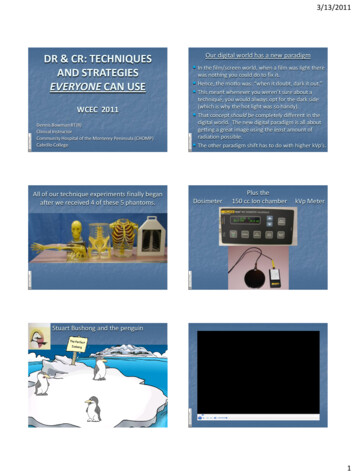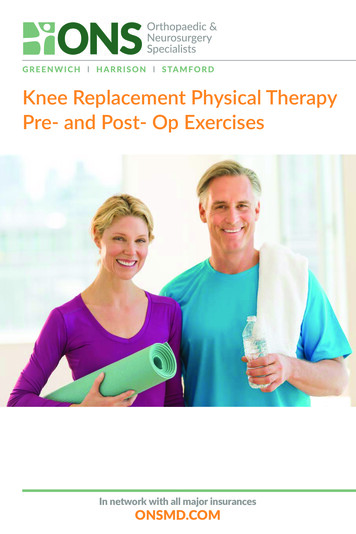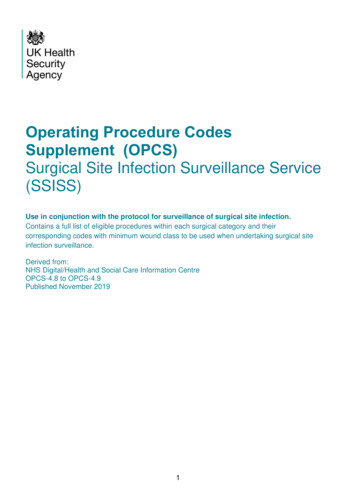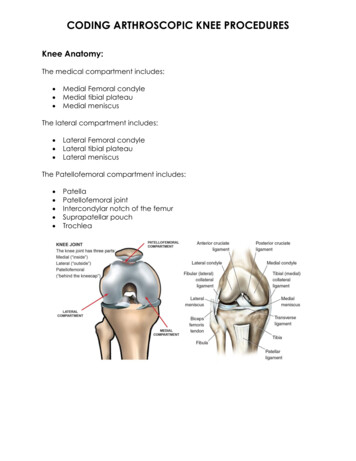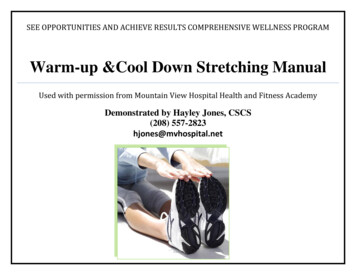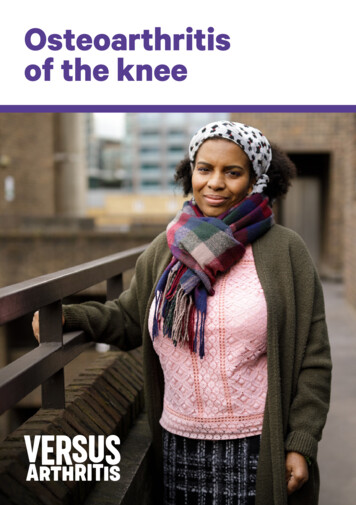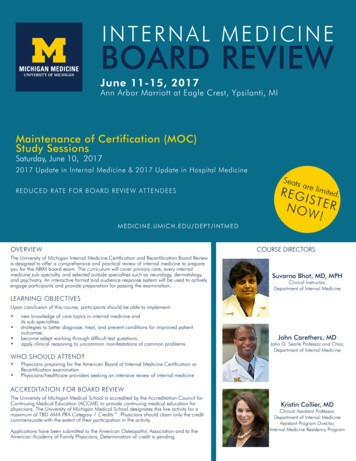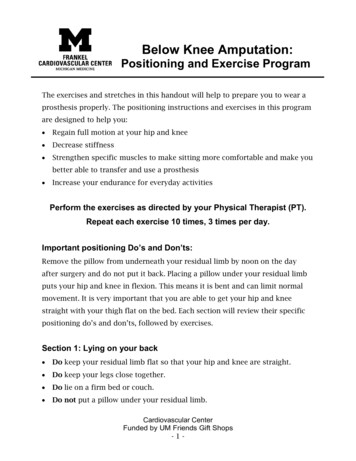
Transcription
Below Knee Amputation:Positioning and Exercise ProgramThe exercises and stretches in this handout will help to prepare you to wear aprosthesis properly. The positioning instructions and exercises in this programare designed to help you: Regain full motion at your hip and knee Decrease stiffness Strengthen specific muscles to make sitting more comfortable and make youbetter able to transfer and use a prosthesis Increase your endurance for everyday activitiesPerform the exercises as directed by your Physical Therapist (PT).Repeat each exercise 10 times, 3 times per day.Important positioning Do’s and Don’ts:Remove the pillow from underneath your residual limb by noon on the dayafter surgery and do not put it back. Placing a pillow under your residual limbputs your hip and knee in flexion. This means it is bent and can limit normalmovement. It is very important that you are able to get your hip and kneestraight with your thigh flat on the bed. Each section will review their specificpositioning do’s and don’ts, followed by exercises.Section 1: Lying on your back Do keep your residual limb flat so that your hip and knee are straight. Do keep your legs close together. Do lie on a firm bed or couch. Do not put a pillow under your residual limb.Cardiovascular CenterFunded by UM Friends Gift Shops-1-
Do not put pillows between your thighs. Do not cross your legs Do not let your residual limb hang over the edge of the bed or couch.Exercise 1: Gluteal Sets- Squeeze your buttocks together. Hold for 5-10seconds. Relax. Repeat.Exercise 2: Quad Sets- Tighten the muscle in front of your thigh by pushingyour knee down to the bed. Hold for 5-10 seconds. Relax. Repeat.Exercise 3: Hip Extension- Pull your non-operative leg up to your chest withyour hands. Push your residual limb down into the bed. Hold for 5-10 seconds.Relax. Repeat. (See Figures 1 and 2)Cardiovascular CenterBelow Knee Amputation: Positioning and Exercise Program-2-
Exercise 4: Bridging— Bend your non-operative leg and place the bottom ofyour foot flat on the bed. Tighten your buttocks while lifting your hips off thebed. Work up to holding for 5-10 seconds. Relax. Repeat. (See figure 3)Exercise 5: Hip Adduction– Place a towel roll between your thighs. Squeeze thetowel roll, keeping your legs flat on the bed. Hold for 5-10 seconds. Relax.Repeat. (See figure 4)Cardiovascular CenterBelow Knee Amputation: Positioning and Exercise Program-3-
Exercise 6: Hip Abduction– Slide your residual limb out to the side as far aspossible, keeping your knee pointing to the ceiling. Return to the middle. Relax.Repeat. (See figure 5)Exercise 7: Straight Leg Raise—Bend your non-operative leg and place thebottom of your foot flat on the bed. Tighten the thigh of the residual limb andslowly lift the residual limb towards the ceiling. Slowly lower the residual limb.Don’t lift your leg higher than the bent knee. Relax. Repeat. (See figure 6)Cardiovascular CenterBelow Knee Amputation: Positioning and Exercise Program-4-
Exercise 8: Hip abduction—Lie on your non-operative side. Lift your residuallimb straight up, keeping your residual limb straight in line with your hip.Relax. Repeat. (See figure 7)Exercise 9: Hip extension—Lie on your non-operative side. Bring your residuallimb to your chest while bending the knee. Move the residual limb backwards asfar as possible while straightening the knee. Relax. Repeat. (See figure 8)Cardiovascular CenterBelow Knee Amputation: Positioning and Exercise Program-5-
Section 2: Lying on your stomach: Do lie on your stomach on a firm bed at least 30 minutes twice a day Do keep both hips flat against the bed, completely straight Do keep your legs close together Do try to sleep on your stomach at night Don’t put pillows under your stomach or hips Don’t put pillows between your thighsExercise 10: Hip extension— Keep your hips flat on the bed. Lift your residuallimb up toward the ceiling, keeping your knee straight. Pause at the top. Relax.Repeat. (See figure 9)Exercise 11: Knee Flexion— Keep your hips flat on the bed. Bend the knee ofyour residual limb as far as possible. Relax until your knee is completelystraight. Relax. Repeat. (See figure 10)Cardiovascular CenterBelow Knee Amputation: Positioning and Exercise Program-6-
Section 3: Sitting Do sit on a firm chair or couch Do sit up straight with your weight equallydistributed onto your hips Do keep your thighs close together Do get up from the sitting position, at leasthourly to stand or walk Don’t let your residual limb move out tothe side away from your other legExercise 12: Knee Extension / Flexion—Straighten the knee of your residual limbcompletely. Hold for 5-10 seconds. Bend theresidual limb as far as possible. Relax.Repeat. (See figure 11)Cardiovascular CenterBelow Knee Amputation: Positioning and Exercise Program-7-
Exercise 13: Chair Push-Ups— Place hands on thearmrests of the chair. Press down and lift your bodyby straightening your arms. Avoid pushing throughyour foot, it should be resting on the floor for balance.Hold for a count of 5 seconds. Slowly, lower yourselfinto the chair. Relax. Repeat. (See figure 12)Section 4: Standing Do try to stand up or walk at least once every wakinghour Do hold your residual limb pointing to the floor whenwalking, with your hip straight Don’t hold your residual limb in front of you or out tothe side when walking Don’t rest residual limb on walker or crutchesCardiovascular CenterBelow Knee Amputation: Positioning and Exercise Program-8-
Balance:When you have a below-knee amputation youlose approximately 6% of your body weight.This means when you move and stand, yourcenter of gravity has shifted. This may makeyou feel off balance until you get used to yournew center of gravity. When you are firsttransferring, standing, and walking you will beprovided assistance and should use a gait belt.The more you move, stand, and walk, thesooner you will learn your new center ofgravity and feel balanced again.Disclaimer: This document contains information and/or instructional materials developed byMichigan Medicine for the typical patient with your condition. It may include links to onlinecontent that was not created by Michigan Medicine and for which Michigan Medicine does notassume responsibility. It does not replace medical advice from your health care providerbecause your experience may differ from that of the typical patient. Talk to your health careprovider if you have any questions about this document, your condition or your treatmentplan.Author: Dawn Allen, PT, DPT, CWS, CCSFunded through a grant from UM Friends Gift ShopsPatient Education by Michigan Medicine is licensed under a Creative Commons AttributionNonCommercial-ShareAlike 3.0 Unported License. Last Revised 09/2018Cardiovascular CenterBelow Knee Amputation: Positioning and Exercise Program-9-
Exercise 9: Hip extension—Lie on your non-operative side. Bring your residual limb to your chest while bending the knee. Move the residual limb backwards as far as possible while straightening the knee. Relax. Repeat. (See figure 8)
